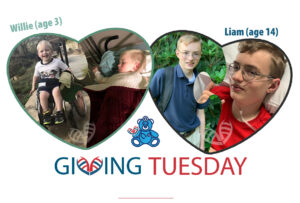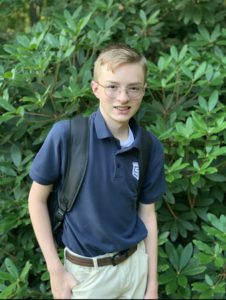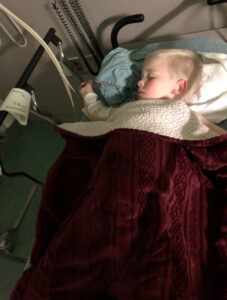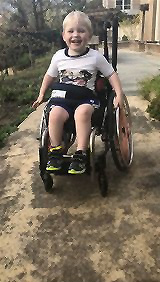Creating hope on Giving Tuesday for our littlest of patients

Liam – age 14
As a little boy, Liam seemed to feel sick very frequently – far more than his two older brothers. He’d have a harder time recovering from illness, being sluggish, tired and missing many days from school. Mary East’s concerns started to grow as her son’s pediatrician visits got more and more frequent. For years, she was told the same things – it’s probably allergies or just a viral infection. But those answers weren’t good enough for Mary. She took him to gastroenterologists, immunologists, requested blood work and more, searching for answers.

It would take nearly a decade to finally get an answer, when Liam was 14. Liam had an invitation to shadow a saxophone student at the state’s Fine Art School in late March 2023 – something he had been looking forward to for months. But that morning while trying to get ready, he told his mom he just couldn’t do it. He wasn’t feeling well. “I knew from his voice, he just sounded so weak and defeated,” Mary remembers. “I was worried, feeling sick so frequently was taking its toll on him.” She took him to the pediatrician once more, and this time the doctor on call noticed a trend – Liam’s hemoglobin levels were very elevated. The doctor asked that they come back for labs the next day. When Mary got home, she read a word on the lab order papers: polycythemia.
Mary poured herself into Google, finding two types of polycythemia: Secondary, arising primarily as a result of disorders that cause hypoxia, or vera – which is a form of blood cancer. Labs that next day showed Liam’s hemoglobin remained high, and he was referred to Children’s Hospital at UAB – which just so happens to be a newly certified HHT Center of Excellence. Still, Liam’s pediatrician seemed confident everything was fine, and that this would just be a simple consultation with a hematologist.
It was spring break that week, and Mary and Liam had a little trip planned. They set off for UAB with their bags packed into the car to leave right after the appointment. Once there, the intake nurse checked Liam’s oxygen saturation levels. When the number popped onto the screen, she went to get a new cable… thinking an error had occurred. She checked again and then began looking for the doctor. The number read; 74. Liam’s blood pressure was also critically low. More doctors and technicians came into the examination room, and an oxygen mask was placed on Liam’s face. “As all this was happening,” Mary recalls, “I remember squeezing his father’s hand and silently pleading, this can’t be real, it can’t be polycythemia vera. They have to find answers.”
 The next few days would be a whirlwind for the East family. Needless to say, their spring break trip would be on hold. Liam was admitted and eventually a chest CT would reveal Liam had several complex pulmonary AVMs – 7 in total. Mary would google PAVMs and for the first time saw the term “HHT.” Not long after, she was speaking to a UAB genetics counselor who found telangiectasia on Mary’s fingers and began talking to her about the disease and family testing.
The next few days would be a whirlwind for the East family. Needless to say, their spring break trip would be on hold. Liam was admitted and eventually a chest CT would reveal Liam had several complex pulmonary AVMs – 7 in total. Mary would google PAVMs and for the first time saw the term “HHT.” Not long after, she was speaking to a UAB genetics counselor who found telangiectasia on Mary’s fingers and began talking to her about the disease and family testing.
In all, Liam would be hospitalized for nine days. Four sets of coils were used in his first embolization, and a plan was in place to treat the PAVMs in phases. Liam went home on heavy oxygen support, and couldn’t go to school. He was unsure how long his life would be like this. While he jokes a perk of the experience was playing so much “Fortnite,” it was a hard adjustment.
“I didn’t understand. All my life I was going out in public without oxygen (support), and all of a sudden I had to have this,” Liam said. Fast forward several months, and today Liam has had a total of four embolizations that have left him with 17 implants – but the Easts are happy to report he is off oxygen and back to his music, running, working out, and being a normal teenager.
Liam’s dream was always to join the Airforce and pursue a musical career with the services. While he may need to adjust that dream a bit, Liam is positive and upbeat about all that he’s experienced. “I feel like if we stay on top of it, this disease isn’t going to stop me from living my life,” Liam says. “I feel like what they can do for HHT is only going to get better over time, too.”His message to his doctors at UAB – including Dr. Junaid Raja, with whom he has a special handshake – is a simple one: Thank you.
Mary wanted to share their family story because she feels so fortunate they are so close to expert HHT care, and wants to encourage others in the community experiencing any symptoms to get tested and scanned. Mary, herself, was eventually found to have HHT and has been diagnosed with a brain AVM. She is currently weighing treatment options.
“It’s been a roller coaster of emotions, it has. But we’re so thankful to finally have answers,” Mary said. “We feel better prepared for our journey ahead thanks to Cure HHT and our team at UAB. We have a lot to be thankful for.”
Willie – age 3
 “March 3, 2019 is a date that forever changed our life.” Willie had just turned 3 years old in January. His mom, Margaret, sent him to his room to take a nap before some bad weather had started approaching our area. Several minutes had passed of him being in his room and I heard him starting to cry out, “Mama… Mama!” She went into his room to see what was wrong and found their little guy army crawling across his floor towards her. Margaret wasn’t sure what had happened, so she picked him and carried him to a chair to hold him. Not long after, they were under a tornado warning. So, Margaret grabbed Willie and his 1-year-old sister, and got into an interior closet. After the storm had passed, they started getting out of the closet and Margaret said, “Willie its OK now. Let’s get out.” He reached up towards her and said, “mama – get me.” She picked him up and tried standing him up to realize he couldn’t bear weight on his legs.
“March 3, 2019 is a date that forever changed our life.” Willie had just turned 3 years old in January. His mom, Margaret, sent him to his room to take a nap before some bad weather had started approaching our area. Several minutes had passed of him being in his room and I heard him starting to cry out, “Mama… Mama!” She went into his room to see what was wrong and found their little guy army crawling across his floor towards her. Margaret wasn’t sure what had happened, so she picked him and carried him to a chair to hold him. Not long after, they were under a tornado warning. So, Margaret grabbed Willie and his 1-year-old sister, and got into an interior closet. After the storm had passed, they started getting out of the closet and Margaret said, “Willie its OK now. Let’s get out.” He reached up towards her and said, “mama – get me.” She picked him up and tried standing him up to realize he couldn’t bear weight on his legs.
Another round of bad weather was approaching and Margaret made the decision to take Willie to urgent care. She measured his bed, which was 11’’ off the ground thinking maybe he had jumped off the bed and hurt his leg. At the urgent care, they x-rayed his left leg and told the family to follow up with the emergency room for the results. Several hours passed and Willie had not wet his diaper or wanted anything to eat or drink, so Margaret then made the decision to bring him to their level 5 pediatric emergency room. At the emergency room they placed his leg in a splint from his hip to toes and sent them home yet again, telling us that he may have a fracture, but he now needed to see pediatric ortho. The following day they decided something still wasn’t right and brought Willie to Children’s Healthcare of Atlanta. “We were seen immediately since now both legs were completely paralyzed.”
Willie was taken for a spinal cord MRI where an AMV rupture was discovered. He was also scanned at that time for brain and chest AVMs as well as blood work confirming HHT. Willie underwent treatment for the ruptured spinal cord vessel, as well as the AVM in his brain and lungs. “We were told by numerous physicians that Willie has permanent spinal cord damage and that he may never walk again or regain his bladder and bowel function.”
Less than 2 months later, Willie was walking and had regained all functions of his little body. During this time his 1 year-old sister Amelia was also diagnosed with HHT, and had to undergo scans and treatment of a lung AVM. Margaret was diagnosed as the HHT carrier through the center for HHT in Dallas, Texas. Both Willie and Amelia continue to get scanned and treated yearly through Children’s Healthcare in Atlanta where they have an amazing team that understands HHT. Willie still has a little bit of trouble with his legs, which requires bracing on longer walking distances. “When people ask about the braces, we gladly share our story because you never know who you can inspire to never give up, and let them know that this condition exists and what to look for.”
“We are so thankful. Willie is 7 years old now and driving tractors and ATV around our farm. Nothing slows him down, it just takes him a little longer to get around some times.”
I wanted to share my story to encourage those who are fortunate enough to have a diagnosis to get tested and scanned. It’s so important.
When you donate today, you can help us create more immediate access to care for our littlest of pediatric patients.
